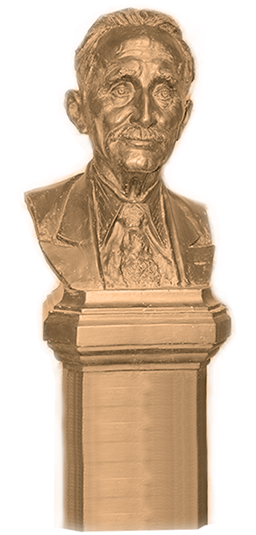
Shaig’s academic work
Academic research was an important part of Shaig’s multifaceted activity. Articles, memoirs and essays written by Shaig were valuable sources of information for schools and academia. His vast research encompassed history and theory of literature, as well as literary criticism.
Abdulla Shaig was one of the founders of literature studies in Azerbaijan which started taking shape in the early XX century. During those years, literature scholars promoted the idea of studying history of literature. They explored the origins and stages of the evolution of literature, and a number of renowned intellectuals such as Ismail Hikmat, Atababa Musakhanli, Abdulla Sur and others offered their own vision and ideas regarding the emergence, origins and main stages of the evolution of national literature. Abdulla Shaig was also among scholars who worked on conceptualization of the history of Azerbaijani literature, making valuable contribution into this process with his original style and vision.
Shaig believed that at the origins of the national written literature stood the poetry of Vagif. Shaig’s strong attachment to Azerbaijani language and literature made him deeply regret the fact that great Azerbaijani poets Nizami Ganjavi and Afzaladdin Khagani wrote in Persian, their works thus not being able to enrich Azerbaijani literature.
According to Shaig, the history of Azerbaijani literature underwent three stages of evolution:
1 – Folk art (Pre-Islamic period)
2 – Oral tradition (from the emergence of Islam to the period of Mirza Fatali Akhundov)
3 – Imitation and quoting (from Mirza Fatali Akhundov to Mirza Alakbar Sabir)
In a number of articles, essays and textbooks Shaig offered impartial academic views on classical literary heritage of Azerbaijan. His views were formed on the basis of both Eastern and Western literary and aesthetical schools of thought which made them more comprehensive and original.
Although realism was present in all spheres of Shaig’s work, in essence he remained romanticist. Thus, the main characteristic of his approach to literary criticism was that it was based on aesthetical origins of romanticism. He chose romanticist writers and their works as main objects of his research. He interpreted the meaning of art from the viewpoint of romanticism. According to Shaig, a work of art can be considered perfect if it touches human soul. He reflected on “pleasure” and “sorrow” and their role in stirring emotions. Shaig’s critical views can be well observed in his article “Thoughts on Javid’s famous play, Iblis (Demon)”. The article offered first interpretation of theoretical and aesthetical principles of tragedy.
The book Literature Lessons co-authored by Abdulla Shaig and Huseyn Javid and published in 1919 is one of the first theoretical works in the history of Azerbaijani literary criticism. Due to its vast scientific coverage which was based on theoretical thought of the East, the book is still valid today.
Along with his articles exploring literary criticism, Shaig produced a number of biographical essays on Sayid Azim Shirvani, Mahammad Fuzuli, Mirza Fatali Akhundov, Abbas Sahhat, Mirza Alakbar Sabir and others. He was the first biographer of most of these masters of Azerbaijani literature.
Arzu Hajiyeva
PhD in philology
____
Scholarly works by Abdulla Shaig
1. Our Language and Literature
2. Role and Importance of Alakbar Sabir in Our Literature
3. Mahammad Hadi Abdussalimzade
4. Role of Tofig Fikrat in history of Turkic literature
5. Role and importance of poetry and literature in life of humans
6. Commonalities and Differencesin Characters and Meaningin Works of Fuzuli and Nafi
7. Reflections on Mirza Fatali Akhundov
8. Thoughts on Javid’s Famous Play, “Iblis”
9.Reflections on “Fooled Stars” by Mirza Fatali Akhundov
10. Fleeting Glimpse of The Literature Emerged Afterthe 1905 Revolution
11. Mirza, Realist Poet and A Classic
12. Lirik el yaradıcılığının xüsusiyyətləri
13. Particularities of Lyrical Folklore
Cavidcə həyat yaşamaq və yaşatmaqdan ibarətdir. Iblis əsərin ilk və son pərdəsinin nəhayətində xalq içində məruf olan əsatiri iblis olaraq göstərilirsə də, Cavidcə iblis öz nəfsinə məğlub olan və yalnız özünü yaşatmaq üçün bəşəriyyəti və onun bir ailəsi olan millətləri zəhərləyən, hürriyyətinə, yaşamasına əngəl olan xain, xudbin adamcıqlar və millətlərdir.
![]()
“Cavidin “İblis” nam hailəsi haqqında duyğularım” məqaləsindən, 1925
Abdulla Şaiqin yaradıcılığı xalqımızın həyatının yarıməsrlik bir dövrünün ədəbi salnaməsidir. Abdulla Şaiqin əsərləri Azərbaycan klassik ədəbiyyatı və xalq yaradıcılığının ən yaxşı ənənələri əsasında yaranmışdır.
Mirzə İbrahimov
...Abdulla Şaiqdən tək bir yazıçı, pedaqoq və maarif xadimi, yalnız tənqidçi, ədəbiyyarşünas və dilşünas kimi, yaxud dərsliklər müəllifi, yüksək əxlaqi-mənəvi keyfiyyətlərə malik vətəndaş və şəxsiyyət kimi ayrı-ayrılıqda danışmaq onun haqqında tam təsəvvür oyada bilməz, buna ancaq ədibin çoxşaxəli fəaliyyətini tam halda əhatə etmək və mənalandırmaqla nail olmaq mümkündür.
Kamal Talıbzadə, 1981

Copyright © 2016 - 2019 - House museum of Abdulla Shaig
Sayt "IT Service" MMC tərəfindən hazırlanmışdır
Bütün hüquqları qorunur.
